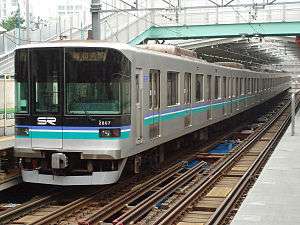Saitama Rapid Railway Line
| Saitama Railway line | |
|---|---|
|
| |
 A Saitama Rapid Railway 2000 series EMU in June 2006 | |
| Overview | |
| Type | Rapid transit |
| Locale | Tokyo, Saitama Prefecture |
| Termini |
Akabane-Iwabuchi Urawa-Misono |
| Stations | 8 |
| Website |
s-rail |
| Operation | |
| Opened | 28 March 2001 |
| Owner | Saitama Railway Corporation |
| Depot(s) | Urawa-Misono |
| Technical | |
| Line length | 14.6 km (9.1 mi) |
| Number of tracks | 2 |
| Track gauge | 1,067 mm (3 ft 6 in) |
| Minimum radius | 248 m |
| Electrification | 1,500 V DC overhead line |
| Operating speed | 80 km/h (50 mph) |
The Saitama Railway Line (埼玉高速鉄道線 Saitama Kōsoku Tetsudō sen) is a mostly underground rapid transit line in Japan operated by the third sector operating company Saitama Railway Corporation. Funded by Saitama Prefecture, local municipal governments, and Tokyo Metro, it forms a continuation of the Tokyo Metro Namboku Line, starting at Akabane-iwabuchi Station in Tokyo and ending at Urawa-Misono Station in Saitama.[1] The line is used as the main means of transportation to Saitama Stadium 2002. On November 27, 2015, the route was nicknamed the "Saitama Stadium Line". The line symbol used in the station numbering is "SR".
Overview
This line allows trains from the Tokyo Metro Namboku Line to operate beyond Akabane-iwabuchi Station into Saitama Prefecture and ending at Urawa-Misono Station.
Most of the line is underground, only Urawa Misono Station and adjacent depots are on the surface. It connects eastern and northern part of Kawaguchi to Tokyo; Areas that were only connected by buses.
Planning for the line stated in 1972 as an extension of the Tokyo Metro Namboku Line which was then referred to as Line 7. The original alignment was planned to serve eastern Urawa and central Kawaguchi in Saitama. In 1985, the alignment was shifted east to Hatogaya. In 1992, the third sector "Saitama High-speed Railway Co., Ltd." was established by Saitama Prefecture, and the construction began in 1995. The line opened on March 28, 2001, ahead of the 2002 FIFA World Cup, which held several matches at the Saitama Stadium close to Urawa-Misono Station.
The total cost of construction is 256.1 billion yen making the cost per kilometer at 17.5 billion yen. Since its opening, the line used six-car trains with all stations (except Urawa-Misono Station) equipped with platforms long enough support future expansion into eight-car trains. Urawa-Misono Station was built as a temporary terminal as the line was planned to be extended further north in the future so it only has platforms long enough for six car trains.
A further extension north beyond Urawa Misono Station connecting Iwatsuki Station of the Tobu Urban Park Line and Hasuda Station of the JR Utsunomiya Line (Tohoku Line) is currently being proposed.
Stations
| No. | Station
color |
Station | Japanese | Distance (km) |
Transfers | Location | |
|---|---|---|---|---|---|---|---|
| ↑ Through-service to/from Hiyoshi via the | |||||||
| SR19 | - | Akabane-Iwabuchi | 赤羽岩淵 | 0.0 | Tōhoku Main Line (Utsunomiya Line, Takasaki Line, Shōnan-Shinjuku Line), Keihin-Tōhoku Line, Saikyō Line (Akabane Station) |
Kita, Tokyo | |
| SR20 | ■ | Kawaguchi-Motogō | 川口元郷 | 2.4 | Kawaguchi | Saitama Prefecture | |
| SR21 | ■ | Minami-Hatogaya | 南鳩ヶ谷 | 4.3 | |||
| SR22 | ■ | Hatogaya | 鳩ヶ谷 | 5.9 | |||
| SR23 | ■ | Araijuku | 新井宿 | 7.5 | |||
| SR24 | ■ | Tozuka-angyō | 戸塚安行 | 10.0 | |||
| SR25 | ■ | Higashi-Kawaguchi | 東川口 | 12.2 | Musashino Line | ||
| SR26 | ■ | Urawa-Misono | 浦和美園 | 14.6 | Midori-ku, Saitama | ||
Rolling stock
- Saitama Rapid Railway 2000 series 6-car EMUs
- Tokyo Metro 9000 series 6-car EMUs
- Tokyu 3000 series 6-car EMUs
- Tokyu 5080 series 6-car EMUs
Shareholders
As of 2013, the main shareholders in Saitama Railway Corporation are as follows.[1]
| Shareholder | Percentage |
|---|---|
| Saitama Prefecture | 45.0 |
| Tokyo Metro | 19.4 |
| City of Kawaguchi | 18.7 |
| City of Saitama | 7.1 |
Ridership
Ridership figures for the line are as follows.[1]
| Fiscal year | Total passengers | Passengers/km day |
|---|---|---|
| 2009 | 30.564 million | 40,038 |
| 2010 | 31.051 million | 40,770 |
| 2011 | 30.983 million | 40,546 |
History
The third sector company, Saitama Railway Corporation, was established on 25 March 1992.[1]
The entire line from Akabane-Iwabuchi to Urawa-Misono opened on 28 March 2001.[1]
Through services to and from Hiyoshi on the Tokyu Meguro Line commenced on 22 June 2008.[1]
Future developments
In the future, the line may be extended north from Urawa-Misono through Iwatsuki-ku, Saitama to Hasuda Station (in Hasuda, Saitama) on the JR East Utsunomiya Line, but financial problems have prevented construction of the extension.
See also
References
External links
| Wikimedia Commons has media related to Saitama Railway. |
- Official website (in Japanese)
- Saitama Prefectural Government information (in Japanese)